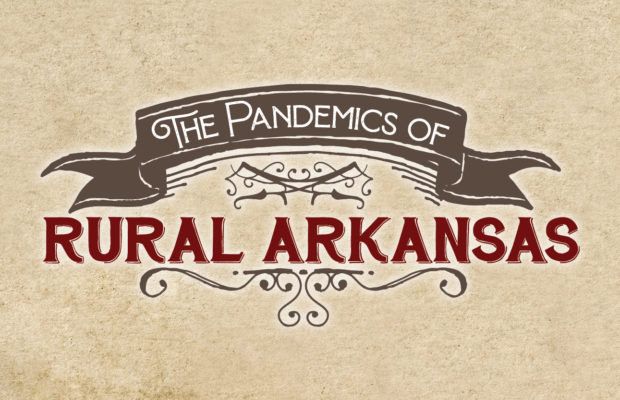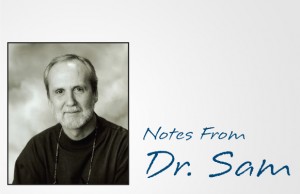The Pandemics of Rural Arkansas

Spanish Flu of 1918 and COVID-19
The Spanish Flu of 1918 and the COVID-19 Pandemic of 2020 had and are having a major impact on rural Arkansas. What causes these illnesses, and how are they different from each other? How did these illnesses get here? Why do they spread so quickly? Who is at risk? Were there treatments in 1918? How about today? How deadly are they? Will they come back? Are these outbreaks predictable?
What causes these illnesses and how are they different from each other?
The Spanish Flu of 1918 did not originate in Spain. The Flu Pandemic of 1918 probably began in Northern China in 1917. It was a novel (new to humans) flu virus brought by Chinese migrant workers into Canada. These workers were being transported across Canada by train and taken to work behind the battle lines in Europe. It was only called the Spanish Flu because the combatants in WW I did not publish their statistics. Spain as a non-combatant had no such restrictions.
COVID-19 is a not a flu virus, it is a type of coronavirus. Most corona viruses cause mild upper respiratory illnesses (colds) in humans. There are at least three corona viruses that cause severe illness and at times, death: SARS (Sever Acute Respiratory Syndrome), MERS (Middle East Respiratory Syndrome) virus and COVID-19.
How did these illnesses get to rural Arkansas, especially in 1918?
The Pandemic Flu of 1918 made its first major appearance in rural Kansas in the spring of 1918 and then quickly spread to a military camp in Central Kansas, Camp Funston. As the men from Camp Funston spread out across the country, 24 of 36 large military camps in the U.S. had major outbreaks during the next year. Among those camps was Camp Pike, just north and west of North Little Rock, Arkansas.
In the fall of 1918, Camp Pike had 54,000 troops, making it the second largest city in Arkansas. Little Rock had a population of 58,000. The first soldier was reported ill on September 23rd, and seven days later there were 7,500 cases of influenza and 100 had died. It is important to remember that, early in many infectious illnesses, a person may be shedding the virus, quite contagious but showing no symptoms themselves.
On Friday, October 4th, 1918, Dr. James C. Geiger, the Public Health officer in charge of the North Little Rock post said, “The situation is well in hand.” This, even though 506 cases had been reported in Little Rock and North Little Rock. The next day he stated, “The disease has reached its highest point and will begin to decline from now on.” Over that long weekend, cases of the flu were reported in Newport, Wilmot, Hot Springs, Stuttgart, Waldron, Subiaco, Paris, Hunter, and Dermott. Despite further official reassurances, on Monday, the 7th of October, Dr. Charles Garrison, a State Board of Health officer, and the Arkansas Board of Health declared a quarantine over the entire state.
The Pandemic Flu of 1918 spread like a wildfire and within days, there was no corner of Arkansas not overwhelmed.
Benton Courier: October 8th, 1918: “Sheriff Cox (Saline County) has received a letter from the State Board of Health advising him to see that all places where public gatherings are held in Saline County are kept closed…To open any place for the purpose of a crowd assembling is in direct violation of the law….”
Benton Courier: October 10th, 1918: “Benton and Vicinity in Grip of Epidemic of Spanish Influenza. Public Places Closed. No epidemic has had its grip on this country and county as has the Spanish influenza, which, during the past week has placed itself in almost every home. The American Bauxite Company had to shut down its plant on Tuesday on account of so many men being sick, and several have died in that section of the county.”
The quarantine was honored in Saline County, but this was not necessarily true in other parts of the state. In Scott, Arkansas, the local authorities failed to stop a circus from performing. Dr. Garrison sent an officer and had the owner of the circus arrested. The Mayor of Booneville chose to ignore the quarantine. Dr. Garrison telegraphed the Mayor and threatened to seal off the town unless the he ordered the quarantine. )
Within days, many towns of Arkansas became ghost towns. The streets were quiet, stores were closed, churches and school grounds stood empty. Businesses and plants did not open because they did not have enough healthy employees. The Benton Courier had trouble producing a newspaper because of employees off sick with the flu. There are numerous accounts of multiple members of households being infected and no one to care for them. Caskets were often makeshift affairs thrown together by able-bodied friends. There are multiple reports of areas in rural Arkansas where there was no one in the family well enough to attend funerals.
Quickly, the flu ceased being a fearful threat and began to take on the names and faces of family and friends.
The physicians, like their patients, were faced with a daunting task. Most health care in 1918 was provided by a physician in a buggy or on horseback who rode a circuit. The roads were often impassable and little more than dirt paths. Dr. H. N. Street of Lonoke (Prairie County) would later relate: “This was the worst epidemic form of any disease I have encountered in thirty years of practice.” Dr. C.W. Dixon of Douglas (Lincoln County)wrote, “I live in the backwoods of Lincoln county. During the epidemic I had quite a territory to cover. I could cover half in one day and the other half the next.”
COVID-19 made its first appearance around the first of December of 2019 in Wuhan, China. An article published in Lancet in January 2020 suggests that the index case (very first patient) was an elderly man who lived in Wuhan, China. He became ill on December 1st, 2019 and within a week, 41 other patients had been diagnosed. The origin of the virus is hotly debated; a wet food market or a virus accidentally leaked from a government lab are thought to be possible sources of the infection.
By late December, genetic testing of the virus identified a SARS-like virus as the culprit. A public notice was released by Wuhan Municipal Health Commission on 31 December and on that same day, the World Health Organization was notified. In December, Chinese officials initially downplayed the extent and severity of the outbreak but soon it was clear that this was a new and severe epidemic.
By mid-January, the virus had spread over much of China and on January 23rd, the Chinese Communist Party declared a “people’s war” and created a major quarantine for Wuhan. Prior to the quarantine, millions of asymptomatic people poured out of the central Chinese city on buses, trains and planes, carrying the virus with them.
On the 21st of January, 2020, the first known case of COVID-19 was confirmed in the United States in the state of Washington. A 35-year-old man had returned from Wuhan on January 15th, and on the 19th was hospitalized with pneumonia.
In late January, the White House established a Coronavirus Task Force and declared a public health emergency placing restrictions on entry for travelers from China but not travel from Europe. By this time, the wildfire had begun and was spreading quickly. February saw little documentation of movement because of a dramatically slow start in testing in the United States.
The first documented death occurred on February 29th, when a 50-year old man with underlying health conditions in Washington state died from COVID-19. On that same date there were only 69 testing-confirmed cases of COVID-19 in the U.S. The Washington Post reported on March 14th that less than 14000 tests had been done nationally. Governor Jay Inslee of Washington State declared a state of emergency and closed the schools; a number of other states followed suit.
On March 11th, 2020, the head of the World Health Organization declared the COVID-19 outbreak a worldwide pandemic.
On that same day, Governor Asa Hutchinson of Arkansas confirmed the first positive case of COVID-19 in Arkansas. The patient was in isolation in a Pine Bluff Hospital. The patient apparently contracted the virus while at Mardi Gras in New Orleans during the last week of February. The Governor signed an executive order declaring a public health emergency in the state of Arkansas.
As a part of the statewide emergency, the Governor emphasized social distancing and hand washing. As early as mid-January, Dr. Nate Smith of the Arkansas Department of Health had created a COVID-19 task force to coordinate the state’s response for a potential outbreak.
On March 12th, four new cases who had contact with the patient in Pine Bluff tested positive. One of those cases was from Saline County.
On March 13th, the president declared a national emergency and many schools and businesses began to close to reduce the spread of the virus.
On March 17, Governor Hutchison closed Arkansas schools until April 20th and two weeks later extended that for the rest of the school year.
On that same day, the Faulkner County Deputy Coroner reported the first Arkansas COVID-19 death, a 91-year old man at a Conway Hospital.
On March 20th, the Governor ordered all bars, gyms and cafes closed, and encouraged people to gather in groups of no more than 10.
By March 29th, the number of confirmed cases in Saline County had increased to five, by April 1st the number was at eleven, and by May 1st that number had risen to 67. On April 3rd, Patti Jacuzzi, a Saline County resident age 72, died due to complications from COVID-19.
Early in the first week of May, the Governor announced the cautious reopening of many of the closed facilities in Arkansas.
It is clear from the Flu Pandemic of 1918 and COVID-19 pandemic that large gatherings and rapid transportation of infected individuals who are asymptomatic (without symptoms) spreads the disease rapidly. In 1918, there were very few good all-weather roads and not many automobiles. The rapid transportation of the day was a spider web of rail lines that covered the state. In 2020, the passenger jet and its ability to be almost anywhere in the world in 24-48 hours is the culprit.
Who is at risk?
Flu was not a new or unusual disease in 1918, but most often it hit the elderly and the young children; they were the most likely to develop severe cases and major complications. This was not the case for the Pandemic Flu of 1918, however. The principal burden fell on young, healthy adults. It may well have been that Arkansas had seen an earlier version of this same flu in 1889-1890, called the Russian Flu. It had made its way through Europe and crossed the Atlantic, and before it was through 365 were dead in rural Arkansas. The immunity created in the survivors may explain why it appeared that the older population had a degree of protection in 1918.
As for COVID-19, it appears that the elderly with pre-existing medical conditions such as diabetes, hypertension, heart disease and cancer are most at risk. As in 1918, those who are confined in group settings such as cruise line ships, large military ships, nursing homes and prison systems are at higher risk of contracting the virus. Smokers and vapers have a higher risk of developing significant lung complications.
What could be done then, and what can be done now about either of these illnesses?
As for the Flu Pandemic, quarantine and avoiding contact with sick people were the only effective tools available in 1918. Wearing flu masks and hand washing were advised but the most important tool was quarantine and avoidance. Then as now many residents of rural Arkansas had a protective barrier in their normal isolation. In the case of the Pandemic flu, this protective shield was only modestly successful and only delayed many of the smaller communities being affected.
Families relied on home remedies; if these failed, they called the doctor. The physician’s armamentarium was limited. Three medicines served as the most commonly used: calomel (mercury), quinine, and Laudanum (opium). These medicines had a long history in treating fevers of other origins, especially calomel and quinine. In hindsight, the mercury made the influenza worse. Quinine may have modulated the fever, and opium had an impact on the muscle aches and headaches associated with the flu.
Patent medicine advertising provided a major part of the revenues for newspapers. Tanlac is a good example of a medicine that was advertised in obvious drug ads in local papers. Most newspapers published articles on the same page with the advertising picture that appeared to be legitimate, quoting U.S. Government authorities. Reading through the articles, it becomes clear that the purpose of the articles was to sell a drug like Tanlac.
There are always those willing to take advantage of the gullible. On October 26th, 1918, Dr. A.M. Davie of DeRoche, Arkansas (Hot Spring county) posted an advertisement in the Malvern paper that read: “Have deposited $25 in the Bank of Malvern and $25 with Hodges and Son in Social Hill. For any case of Spanish Influenza, I am not able to cure in 30 minutes.”
As for COVID-19, it is clear we are in the early stages of determining what will be effective. As with almost all respiratory disease, social distancing, hand washing, and face masks are common sense and remain effective tools. The quarantining of those who are ill and those who are potentially ill is absolutely essential to stop the spread of disease As opposed to 1918, we now have effective intensive care units with respiratory support ventilators and complex medical regimens that seem to work.
There is promise of medications such as Remdesivir that can shorten the length of the illness and reduce mortality. Convalescent Immune therapy is showing some promise. Blood serum rich in anti- COVID-19 antibodies, taken from a recovering patient and given to someone who has active disease; helps to create a passive immunity.
A vaccine seems to be a realistic possibility within the next 8-12 months. Now for the downside: for those requiring a ventilator, optimistically, only about 50% survive. A number of critically ill COVID-19 patients develop a form of coagulopathy (clotting disorder) that dramatically complicates the illness.
Quackery and false or misleading claims of cures continue to draw in the gullible and often do great harm. Excellent examples such as the touting of hydroxychloroquine and the suggestion that ultraviolet light and or ingestion of disinfectants might be something to try have been promoted. Religious charlatans claiming the curing power of the laying on of hands and of magical prayer cloths are in the same category.
How deadly are these illnesses?
The Flu pandemic of 1918 occurred in three waves: the first was in the spring of 1918, then an especially vicious round in October of 1918 and a follow-up in the winter/spring of 1919. Estimates are that 500 million people were infected worldwide (1/3 of the world population) and between 30-50 million died. Numbers vary greatly but most experts believe the Flu Pandemic of 1918 had a mortality rate of approximately 2.5%. To put that in perspective, the Seasonal Flu has a 0.1 % mortality rate; doing the math, the Pandemic Flu was 25 times as lethal as the Seasonal Flu.
Statistics from that era, and especially in Arkansas, are particularly inaccurate but estimates are that 600,000 died in the U.S. and 7,000 in Arkansas. There is no way to know for absolutely certain how many died in Saline county, but what data are available make it clear that the county suffered like the rest of the state.
The Funeral Registry at Ashby’s Funeral Home in Benton is one of the only dependable records that we have. For the years of 1917,1918 and 1919, the funeral home averaged seven to fifteen funerals per month, except for the month of October of 1918 when they performed seventy-one funerals; in November of 1918, the funeral home was back to its normal rate of deaths and funerals.
As for COVID-19, it is impossible to know at this point what the mortality rate will be for this illness. As early as March 2020, the World Health Organization suggested that the mortality rate for COVID-19 might be as high as 3.4 %. Since that time, it has become quite clear that a significant number of people who have the virus have no symptoms at all. An article in Forbes Magazine recently suggested the number might be as high as 15-20% of those infected who are asymptomatic. It will take extensive random testing over the next months and years to determine the exact rates of lethality of this virus.
Will this illness come back?
Benton Courier: October 31 1918: “Influenza Situation Improving Rapidly: Although there are several cases of influenza over the county, it is believed that the epidemic has spent its force in Saline County, and the quarantine has been raised.”
As Arkansas neared the end of October of 1918, it was obvious that the number of new cases of flu in the state had dramatically dropped. Several localities in the state had no flu at all. By Nov 4th, the statewide quarantine was lifted but it was left up to individual counties based on their situations. In early to mid-November there was a resurgence of the virus in south Arkansas causing the Board of Health to consider re-instating the quarantine, but that spell passed. In the winter of 1919, there was one more brief round of the Pandemic but, in the end, that passed as well.
Will COVID-19 come back? A more important question, at this point, is: Will it go away? Two different approaches have been taken to deal with the virus. One approach is based on allowing the virus to spread creating a major spike in cases and then hopefully the virus will recede. A second approach was designed to flatten the curve (spike) by using avoidance, closing schools, limiting crowds at churches gym and restaurants, and varying levels of quarantine-like procedures.
The predicted result was a disease that would not overwhelm the medical facilities and eventually develop enough immunity in the community to stop the spread of the virus. Will the virus re-appear in the fall for another wave? The experts are of a mixed mind. Herd immunity is a phrase that is used to describe what needs to happen. Herd immunity occurs when 60 percent of the community has some form of immunity that will not allow the virus to spread.
That immunity can occur when individuals have had the infection, have recovered, and are now making their own antibodies. It can also occur as a result of a virus-specific vaccine. Because of a lack of testing, it is not known what part of the community has been exposed and have some immunity. It appears that much is riding on widespread testing and the timely development of a vaccine or other effective treatment.
What are the long-term consequences to Pandemics?
Pandemics have besieged humans for at least 2,500 years. The Antonine Plague in the second century A.D. is said to have played a role in the fall of the Roman Empire. The Black Plague in the 14th century killed off millions and altered the world economy. The Columbian exchange in the Western Hemisphere starting in the 16th century killed off 90-95% of the native populations of the Western Hemisphere.
The short-term economic consequences of the Pandemic Flu of 1918 in Arkansas were well-documented. Merchants in Little Rock recorded drops of 40-70% in their business. This was equally true throughout the state. A study done in 2007 on the long-term economic impact suggests that those born during the time of the epidemic had reduced educational attainment, higher rates of physical disability and lower incomes. Because of its propensity to strike young adults, the flu had a lingering effect on business and social life well into the 1920s.
Clearly, COVID-19 has had obvious major short-term economic consequences. As to the long-term consequences, the jury is out.
Will this happen again?
The leaders of the CDC and the World Health organization have repeatedly made it clear that the next pandemic was (and is) a matter of WHEN and not IF. Just before he retired in 2017, Tom Frieden, the head of the Centers for Disease Control and Prevention, was asked what his greatest fear was, what kept him awake at night: “The biggest concern is always for a pandemic…[It] really is the worst-case scenario. If you have something that spreads to a third of the population and can kill a significant proportion of those it affects, you have the makings of a major disaster.
The Bush administration made important investments in public health, global public health and in preparedness, and in the Obama administration, we have built on those. It’s a baton that gets passed. Preparedness is really important.”
Epilogue
We will survive this, but we will be changed. There is resilience in the human psyche. Whether the foe is pestilence, war, natural catastrophes like storms and earthquakes, or man-made debacles like economic depression, humans pick themselves up, brush off the mud and go on. I suspect this time will be the same.










0 comments